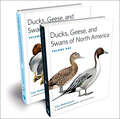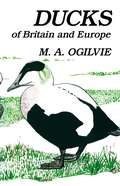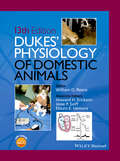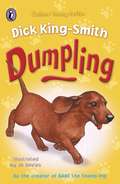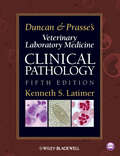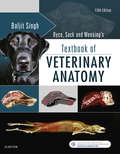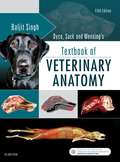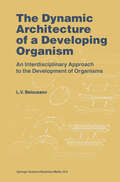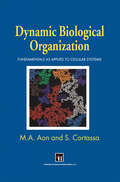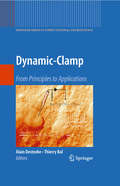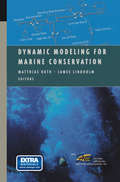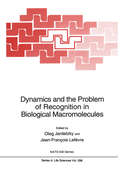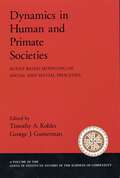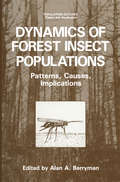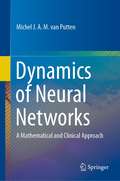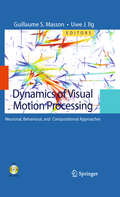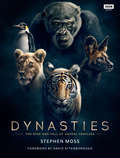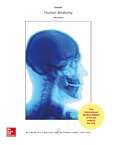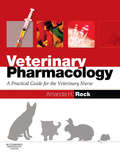- Table View
- List View
Ducks, Geese, and Swans of North America
by Guy BaldassarreDucks, Geese, and Swans of North America has been hailed as a classic since the first edition was published in 1942. A must-have for professional biologists, birders, waterfowl hunters, decoy collectors, and wildlife managers, this fully revised and updated edition provides definitive information on the continent's forty-six species. Maps of both winter and breeding ranges are presented with stunning images by top waterfowl photographers and the acclaimed original artwork of Robert W. (Bob) Hines. Originally authored by F. H. Kortright and later revised by Frank Bellrose, this latest edition, which has been meticulously updated by renowned waterfowl biologist Guy Baldassarre, continues the legacy of esteemed authors. Each species account contains in-depth sections on: • identification• distribution• migration behavior• habitat• population status• breeding biology• rearing of young• recruitment and survival• food habits and feeding ecology • molts and plumages• conservation and management To facilitate identification, the species accounts also include detailed illustrations of wings. An appendix contains comparative illustrations of ducklings, goslings, and cygnets.This edition of Ducks, Geese, and Swans consists of two volumes, printed in full color, and packaged in a slipcase, along with a CD containing references and additional maps.
Ducks of Britain and Europe (Poyser Monographs)
by M. A. OgilvieThe forty-two species or subspecies of ducks which occur in Europe, including eleven vagrants from North America or Asia, are the subject of this book. Its author is an accepted authority on ducks and geese, and has been a member of the research staff of the Wildfowl Trust at Slimbridge since 1960.Most birdwatchers consider ducks to be especially attractive and interesting birds, and many species of ducks are also the legitimate quarry of wildfowlers. Both groups need to identify the species quickly and accurately, and almost half of the book is devoted to identification, offering a far more detailed account than is to be found in any of the field guides. There are detailed descriptions, species by species, of the adult males and females, immature birds, eclipse males, and downy young - voice, too, is dealt with - and full-colour plates of males and females show the flight patterns, so important for correct species identification.The habits of European ducks are treated in chapters on behaviour and ecology, breeding biology, distribution and status, and the ever-fascinating topic of migration and navigation. The distribution chapter has maps showing the summer and winter ranges in Europe, North Africa, the Middle East and Central Russia, for 24 species.?A final chapter considers the present day threats to ducks and their wetland habitats, and the conservation measures being taken to combat the threats.The colour plates and more than 80 line drawings in the text are by Carol Ogilvie, the author's wife.Jacket illustration by Carol Ogilvie
Ducks of Britain and Europe (Poyser Monographs #116)
by M. A. OgilvieThe forty-two species or subspecies of ducks which occur in Europe, including eleven vagrants from North America or Asia, are the subject of this book. Its author is an accepted authority on ducks and geese, and has been a member of the research staff of the Wildfowl Trust at Slimbridge since 1960.Most birdwatchers consider ducks to be especially attractive and interesting birds, and many species of ducks are also the legitimate quarry of wildfowlers. Both groups need to identify the species quickly and accurately, and almost half of the book is devoted to identification, offering a far more detailed account than is to be found in any of the field guides. There are detailed descriptions, species by species, of the adult males and females, immature birds, eclipse males, and downy young - voice, too, is dealt with - and full-colour plates of males and females show the flight patterns, so important for correct species identification.The habits of European ducks are treated in chapters on behaviour and ecology, breeding biology, distribution and status, and the ever-fascinating topic of migration and navigation. The distribution chapter has maps showing the summer and winter ranges in Europe, North Africa, the Middle East and Central Russia, for 24 species.?A final chapter considers the present day threats to ducks and their wetland habitats, and the conservation measures being taken to combat the threats.The colour plates and more than 80 line drawings in the text are by Carol Ogilvie, the author's wife.Jacket illustration by Carol Ogilvie
Ducks (UEB uncontracted)
by Adrian FarnsworthThe first page shows an image of a duck followed by three small ducklings shown from the side. They are all facing and paddling to the left. The second page shows an image of a diving duck shown from the side, facing and paddling to the left.
Dukes' Physiology of Domestic Animals
by Howard H. Erickson Jesse P. Goff Etsuro E. UemuraThis fully revised new edition of the classic reference on domestic animal physiology provides detailed descriptions of animal function and dysfunction, with an emphasis on clinical relevance and pedagogical features to enhance learning. • Presents in-depth, comprehensive descriptions of domestic animal function and dysfunction • Emphasizes clinical relevance, with clinical correlations, notes of relevance, and self-assessment questions featuring situations likely to be faced in practice • Offers pedagogical features, including chapter outlines and introductions, key terms throughout the book, additional images, questions to enhance learning, and self-assessment exercises • Distills the most useful information for ease of use, with improved continuity and reduced repetition • Includes a companion website offering review questions and answers and the figures from the book in PowerPoint
Dukes' Physiology of Domestic Animals
by Howard H. Erickson Jesse P. Goff Etsuro E. UemuraThis fully revised new edition of the classic reference on domestic animal physiology provides detailed descriptions of animal function and dysfunction, with an emphasis on clinical relevance and pedagogical features to enhance learning. • Presents in-depth, comprehensive descriptions of domestic animal function and dysfunction • Emphasizes clinical relevance, with clinical correlations, notes of relevance, and self-assessment questions featuring situations likely to be faced in practice • Offers pedagogical features, including chapter outlines and introductions, key terms throughout the book, additional images, questions to enhance learning, and self-assessment exercises • Distills the most useful information for ease of use, with improved continuity and reduced repetition • Includes a companion website offering review questions and answers and the figures from the book in PowerPoint
Dumm wie ein Fisch?: Die überraschende Intelligenz unter Wasser
by Horst BleckmannGegenüber den Säugetieren werden Fische häufig unterschätzt und als weniger komplexe Organismen abgetan. Um diesen voreiligen Schluss zu entkräften, präsentiert Ihnen Horst Bleckmann die hochentwickelten kognitiven Fähigkeiten der Fische.Wussten Sie z.B., dass Fische mit ca. 30.000 Arten die größte Gruppe aller Wirbeltiere stellen und alle aquatischen Lebensräume besiedeln? Für diese immense Leistung haben sie eine Vielzahl von hochspezialisierten Sinnessystemen und Verhaltensweisen entwickelt. Nach neueren Forschungen verfügen Fische zudem nicht nur über äußerst raffinierte Sinnesorgane, sondern auch über hochentwickelte Zentralnervensysteme, die in ihrer Grundstruktur ähnlich aufgebaut sind wie die Gehirne der Säuger.Tauchen Sie in eine faszinierende Welt ein und lernen Sie alles über die verschiedenen Sinnessysteme der Fische kennen. Ein abschließendes Kapitel behandelt ergänzend die weltweite Bedrohung der Fische durch Gewässerverschmutzung, Querbauten in Fließgewässern und die Fischereiwirtschaft.
Dumpling
by Dick King-SmithA very funny animal story for young readers by award-winning writer Dick King-Smith.Dumpling wishes she was long and sausage-shaped like her two brothers and other dachshunds, instead of being short and stumpy. One day she goes to the woods and meets a witch's cat who grants Dumpling her wish, but the spell goes wrong and Dumpling gets longer and longer! She's very happy to return to her own shape again.
Duncan and Prasse's Veterinary Laboratory Medicine: Clinical Pathology
by Kenneth S. LatimerNow in full color throughout, Duncan and Prasse’s Veterinary Laboratory Medicine: Clinical Pathology, Fifth Edition offers a comprehensive overview of hematology, hemostasis, clinical chemistry, urinalysis, cytology, and reference intervals in a highly accessible outline format. With information on all major domestic species, the text is designed for the reader to quickly find answers to clinical questions. Taking a problem-solving approach to the interpretation of laboratory data, this book includes clinical cases to illustrate the concepts of laboratory data interpretation, with tables and key words to aid readers in locating and applying information. The fifth edition has been fully revised to reflect the latest knowledge, diagnostic methods, and practices in veterinary laboratory medicine. A companion website provides the images in PowerPoint and references linked to PubMed at www.wiley.com/go/latimer. Duncan and Prasse’s Veterinary Laboratory Medicine is an excellent quick reference for practicing veterinarians, veterinary students, clinical interns and residents, and pathology residents.
Duncan and Prasse's Veterinary Laboratory Medicine: Clinical Pathology
by Kenneth S. LatimerNow in full color throughout, Duncan and Prasse’s Veterinary Laboratory Medicine: Clinical Pathology, Fifth Edition offers a comprehensive overview of hematology, hemostasis, clinical chemistry, urinalysis, cytology, and reference intervals in a highly accessible outline format. With information on all major domestic species, the text is designed for the reader to quickly find answers to clinical questions. Taking a problem-solving approach to the interpretation of laboratory data, this book includes clinical cases to illustrate the concepts of laboratory data interpretation, with tables and key words to aid readers in locating and applying information. The fifth edition has been fully revised to reflect the latest knowledge, diagnostic methods, and practices in veterinary laboratory medicine. A companion website provides the images in PowerPoint and references linked to PubMed at www.wiley.com/go/latimer. Duncan and Prasse’s Veterinary Laboratory Medicine is an excellent quick reference for practicing veterinarians, veterinary students, clinical interns and residents, and pathology residents.
Dyce, Sack and Wensing's Textbook of Veterinary Anatomy - E-Book
by Baljit SinghGain the working anatomic knowledge that is crucial to your understanding of the veterinary basic sciences with Textbook of Veterinary Anatomy, 5th Edition. By focusing on the essential anatomy of each species, this well-established book details information directly applicable to the care of dogs, cats, horses, cows, pigs, sheep, goats, birds, and camelids — and points out similarities and differences among species. Each chapter includes a conceptual overview that describes the structure and function of an anatomic region, and new diagrams facilitate comprehension of bodily functions.Comprehensive coverage of a multitude of species (dogs, cats, birds, horses, cows, pigs, sheep, goats, and now camelids) provides comparative anatomic information all in one resource.Focuses on essential anatomy of each species, making this text ideal for any veterinary school curriculum that is covering the same amount of material in a reduced number of hours for course completion.Clinical cases throughout relate actual cases to the study of anatomy to increase your understanding of how patients will present in practice.Evolve site for students and instructors with a test bank, sample flash cards, and an image collection reinforces your understanding of veterinary anatomy — and helps you prepare for the NAVLE board exam.Content is logically organized into two main sections – a general introduction to mammalian anatomy and a region-specific breakdown – to make studying more efficient and ensure greater understanding.Flash cards and coloring book support the text and give you the opportunity to study anatomy in different ways to increase retention of what you have learned.NEW and EXPANDED! New and updated diagrams further illustrate the anatomic structure and function of each species to facilitate comprehension of bodily functions, presenting the closest thing possible to an actual "hands-on" clinical experience.EXPANDED! A 500-question Test Bank, designed for optimal NAVLE board exam preparation, lets you practice answering board-type questions.UPDATED! New information on the anatomy of camelids, a species that is gaining importance in farm animal practice, provides an overview of the camelid anatomy and highlights any major differences compared to other species.
Dyce, Sack, and Wensing's Textbook of Veterinary Anatomy (Fifth Edition) (PDF)
by Keith Dyce Baljit SinghGain the working anatomic knowledge that is crucial to your understanding of the veterinary basic sciences with Textbook of Veterinary Anatomy, 5th Edition. By focusing on the essential anatomy of each species, this well-established book details information directly applicable to the care of dogs, cats, horses, cows, pigs, sheep, goats, birds, and camelids — and points out similarities and differences among species. Each chapter includes a conceptual overview that describes the structure and function of an anatomic region, and new diagrams facilitate comprehension of bodily functions.
The Dynamic Architecture of a Developing Organism: An Interdisciplinary Approach to the Development of Organisms
by L.V. BeloussovFor anybody capable of an emotional response to it, any view of a developing organism should give birth to a feeling of amazement and even admiration, whether this development is seen directly, or in the form of a time lapse film, or even if mentally reconstructed from a series of static images. We ask ourselves how such seemingly primitive eggs or pieces of tissue, without any obvious intervention from outside, so regularly transform themselves into precisely constructed adult organisms. If we try to formulate what amazes us most of all about development, the answer will probably be that it is the internal capacity of developing organisms themselves to create new structures. How, then, can we satisfy our amazement in ways that are more or less reasonable, as well as scientifically valuable? This depends, first of all, on what position we choose to regard embryonic development as occupying among other structure creating processes, even including human activities. On the one hand, one might regard the development of organisms as a highly specialized class of processes, unique to themselves and alien to the general laws of nature, or at least not derivable from them and more akin to the deliberate acts of our own human behaviour. In that case our task would become reduced to a search for some specific 'instructions' for each next member of such a class. Whether in an overt or hidden form, some such ideology seems to dominate in present day developmental biology.
Dynamic Biological Organization: Fundamentals as Applied to Cellular Systems
by Miguel A. Aon S. CortassaDynamic Biological Organization is a fascinating account of the living organisms as dynamic systems, based on the concept that the spatio-temporal coherence of events within a living system result from the intrinsic dynamics of the processes taking place within that sysem. The authors of this important work, Miguel Aon and Sonia Cortassa have travelled widely to work in some of the leading research laboratories to accumulate a large information base on which to assemble this book. Taking a transdisciplinary approach, the authors draw on work at the interface of biochemistry, genetics, physiology, thermodynamics, kinetics and biomathematics, using mathematical models throughout to corroborate and analyze the biological complexity presented. Emphasizing biological processes occuring at the cellular level. Dynamic Biological Organization gives exciting insights into the experimental and theoretical applications of modern scientific paradigms to fundamental biological processes.
Dynamic-Clamp: From Principles to Applications (Springer Series in Computational Neuroscience #1)
by Thierry Bal Alain DestexheDynamic-clamp is a fascinating electrophysiology technique that consists of merging living neurons with computational models. The dynamic-clamp (also called “conductance injection”) allows experimentalists and theoreticians to challenge neurons (or any other type of cell) with complex conductance stimuli generated by a computer. The technique can be implemented from neural simulation environments and a variety of custom-made or commercial systems. The real-time interaction between the computer and cell also enables the design of recording paradigms with unprecedented accuracy via a computational model of the electrode. Dynamic-Clamp: From Principles to Applications contains contributions from leading researchers in the field, who investigate these paradigms at the cellular or network level, in vivo and in vitro, and in different brain regions and cardiac cells. Topics discussed include the addition of artificially-generated synaptic activity to neurons; adding, amplifying or neutralizing voltage-dependent conductances; creating hybrid networks with real and artificial cells; attaching simulated dendritic tree structures to the living cell; and connecting different neurons. This book will be of interest to experimental biophysicists, neurophysiologists, and cardiac physiologists, as well as theoreticians, engineers, and computational neuroscientists. Graduate and undergraduate students will also find up-to-date coverage of physiological problems and how they are investigated.
Dynamic Modeling for Marine Conservation (Modeling Dynamic Systems)
by Matthias Ruth E. A. Norse James LindholmThe effects of disturbed ecosystems, from devastating algal blooms to the loss of whale populations, have demonstrated the vulnerability of the oceans'biodiversity. This book provides methods for learning how ocean systems function, how natural and human actions put them in peril, and how we can influence the marine world in order to maintain biodiversity. The difficulties of research in the oceans make computer modeling particularly helpful for marine conservation. The authors demonstrate dynamic modeling through the use of the STELLA modeling program and case studies from marine conservation.
Dynamics and the Problem of Recognition in Biological Macromolecules (Nato Science Series A: #288)
by Jean-FrançoisLefèvre OlegJardetzkyFrom within complex structures of organisms and cells down to the molecular level, biological processes all involve movement. Muscular fibers slide on each other to activate the muscle, as polymerases do along nucleic acids for replicating and transcribing the genetic material. Cells move and organize themselves into organs by recognizing each other through macromolecular surface-specific interactions. These recognition processes involve the mu tual adaptation of structures that rely on their flexibility. All sorts of conformational changes occur in proteins involved in through-membrane signal transmission, showing another aspect of the flexibility of these macromolecules. The movement and flexibility are inscribed in the polymeric nature of essential biological macromolecules such as proteins and nucleic acids. For instance, the well-defined structures formed by the long protein chain are held together by weak noncovalent interac tions that design a complex potential well in which the protein floats, permanently fluctuating between several micro- or macroconformations in a wide range of frequencies and ampli tudes. The inherent mobility of biomolecular edifices may be crucial to the adaptation of their structures to particular functions. Progress in methods for investigating macromolecular structures and dynamics make this hypothesis not only attractive but more and more testable.
Dynamics in Human and Primate Societies: Agent-Based Modeling of Social and Spatial Processes (Santa Fe Institute Studies on the Sciences of Complexity)
by Timothy A. Kohler George G. GumermanAs part of the SFI series, this book presents the most up-to-date research in the study of human and primate societies, presenting recent advances in software and algorithms for modeling societies. It also addresses case studies that have applied agent-based modeling approaches in archaeology, cultural anthropology, primatology, and sociology. Many things set this book apart from any other on modeling in the social sciences, including the emphasis on small-scale societies and the attempts to maximize realism in the modeling efforts applied to social problems and questions. It is an ideal book for professionals in archaeology or cultural anthropology as well as a valuable tool for those studying primatology or computer science.
Dynamics of Forest Insect Populations: Patterns, Causes, Implications (Population Ecology)
by Alan A. BerrymanInsects multiply. Destruction reigns. There is dismay, followed by outcry, and demands to Authority. Authority remembers its experts or appoints some: they ought to know. The experts advise a Cure. The Cure can be almost anything: holy water from Mecca, a Government Commis sion, a culture of bacteria, poison, prayers denunciatory or tactful, a new god, a trap, a Pied Piper. The Cures have only one thing in common: with a little patience they always work. They have never been known entirely to fail. Likewise they have never been known to prevent the next outbreak. For the cycle of abundance and scarcity has a rhythm of its own, and the Cures are applied just when the plague of insects is going to abate through its own loss of momentum. -Abridged, with insects in place of voles, from C. Elton, 1924, Voles, Mice and Lemmings, with permission of Oxford University Press This book is an enquiry into the "natural rhythms" of insect abundance in forested ecosystems and into the forces that give rise to these rhythms. Forests form unique environ ments for such studies because one can find them growing under relatively natural (pri meval) conditions as well as under the domination of human actions. Also, the slow growth and turnover rates of forested ecosystems enable us to investigate insect popula tion dynamics in a plant environment that remains relatively constant or changes only slowly, this in contrast to agricultural systems, where change is often drastic and frequent.
Dynamics of Neural Networks: A Mathematical and Clinical Approach
by Michel J.A.M. van PuttenThis book treats essentials from neurophysiology (Hodgkin–Huxley equations, synaptic transmission, prototype networks of neurons) and related mathematical concepts (dimensionality reductions, equilibria, bifurcations, limit cycles and phase plane analysis). This is subsequently applied in a clinical context, focusing on EEG generation, ischaemia, epilepsy and neurostimulation. The book is based on a graduate course taught by clinicians and mathematicians at the Institute of Technical Medicine at the University of Twente. Throughout the text, the author presents examples of neurological disorders in relation to applied mathematics to assist in disclosing various fundamental properties of the clinical reality at hand. Exercises are provided at the end of each chapter; answers are included. Basic knowledge of calculus, linear algebra, differential equations and familiarity with MATLAB or Python is assumed. Also, students should have some understanding of essentials of (clinical) neurophysiology, although most concepts are summarized in the first chapters. The audience includes advanced undergraduate or graduate students in Biomedical Engineering, Technical Medicine and Biology. Applied mathematicians may find pleasure in learning about the neurophysiology and clinic essentials applications. In addition, clinicians with an interest in dynamics of neural networks may find this book useful, too.
The Dynamics of Thought (Synthese Library #300)
by Peter GardenforsThis book is a selection from the articles that I have written over a period of more than twenty years. Since the focus of my research interests has shifted several times during this period, it would be difficult to identify a common theme for all the papers in the volume. Following the Swedish tradition, I therefore present this as a smörgåsbord of philosophical and cognitive issues that I have worked on. To create some order, I have organized the sixteen papers into five general sections: (1) Decision theory; (2) belief revision and nonmonotonic logic; (3) induction; (4) semantics and pragmatics; and (5) cognition and evolution. Having said this, I still think that there is a common theme to my work over the years: The dynamics of thought. My academic interests have all the time dealt with aspects of how different kinds of knowledge should be represented, and, in particular, how changes in knowledge will affect thinking. Hence the title of the book.
Dynamics of Visual Motion Processing: Neuronal, Behavioral, and Computational Approaches
by Uwe J. Ilg Guillaume S. MassonMotion processing is an essential piece of the complex brain machinery that allows us to reconstruct the 3D layout of objects in the environment, to break camouflage, to perform scene segmentation, to estimate the ego movement, and to control our action. Although motion perception and its neural basis have been a topic of intensive research and modeling the last two decades, recent experimental evidences have stressed the dynamical aspects of motion integration and segmentation. This book presents the most recent approaches that have changed our view of biological motion processing. These new experimental evidences call for new models emphasizing the collective dynamics of large population of neurons rather than the properties of separate individual filters. Chapters will stress how the dynamics of motion processing can be used as a general approach to understand the brain dynamics itself.
Dynasties: The Rise and Fall of Animal Families
by Stephen Moss David AttenboroughFamily isn't just important. It's everything. From lions hunting as a pride to penguins huddling together to keep from freezing in the bitter Antarctic winter, many animals are dependent on complex social relationships for their survival. Powerful dynasties lay claim to vast swathes of territory, fighting off rivals and securing their hunting grounds for generations to come. Dynasties offers an immersive insight into the shifting hierarchies of animal families. Each chapter follows a different dynasty, from the Marsh Lions of the Masai Mara to rival packs of painted wolves, from a tiger protecting her newborn cubs to a chimpanzee troop and the penguin colonies of the Antarctic. Alongside tender moments when bonds are strengthened through grooming and play, the book charts the rivalries that tip the balance of power, when family members turn against each other and younger animals grow strong enough to challenge for control. With over 200 stunning photographs and insights from the crew of the BBC series, Dynasties reveals in astonishing detail the intricate social lives of our planet’s most fascinating animals.
E-book: Human Anatomy (UK Higher Education Science & Technology Bioscience)
by SaladinE-book: Human Anatomy
E-Book - Veterinary Pharmacology: A Practical Guide for the Veterinary Nurse
by Amanda Helen RockThis title is directed primarily towards health care professionals outside of the United States. Designed and written specifically for veterinary nurses, it focuses on the practical application of knowledge and encourages a problem-solving approach by introducing a discussion of the potential uses of drugs and exploring a variety of therapies. The text builds upon a general background of anatomy and physiology, chemical sciences and microbiology enabling the reader to understand and engage with the topic more fully. Photographs and detailed line drawings illustrate the more complex areas of pharmacology and aid comprehension of the general action mechanisms of the various drugs discussed. Complicated concepts are presented in a user-friendly way to maximise understanding.The first book on pharmacology that meets the needs of every veterinary nurse - from student to qualified Each chapter is headed with a list of learning outcomes for easy useInclusion of self-test questions to aid revisionA useful reference tool in clinical situationsOffers practical advice on pharmacy managementRecent research into drug therapy is included and future pharmacological therapies and recommended treatment protocols are discussed
